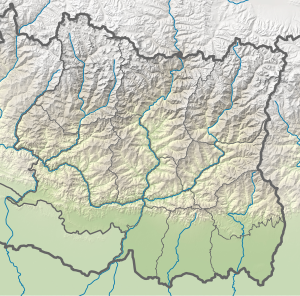Menchhayayem (Nepali: मेन्छयायेम गाउँपालिका) is a rural municipality (gaunpalika) out of four rural municipality located in Tehrathum District of Koshi Province of Nepal. There are a total of 6 municipalities in Tehrathum in which 2 are urban and 4 are rural.
Menchhayayem
मेन्छयायेम गाउँपालिका | |
|---|---|
| Coordinates: 27°13′N 87°30′E / 27.22°N 87.5°E | |
| Province | Koshi Province |
| District | Tehrathum |
| Wards | 6 |
| Established | 10 March 2017 |
| Government | |
| • Type | Rural Council |
| • Chairperson | Mr. Yadav Khapung (NCP) |
| • Vice-chairperson | Mrs. Gitadevi Timsina Gautam (NC) |
| Area | |
• Total | 70.09 km2 (27.06 sq mi) |
| Population (2011) | |
• Total | 807i |
| Time zone | UTC+5:45 (Nepal Standard Time) |
| Headquarter | Morahang |
| Website | official website |
According to Ministry of Federal Affairs and Local Developme Menchhayayem has an area of 70.09 square kilometres (27.06 sq mi) and the total population of the municipality is 8078 as of Census of Nepal 2011.[1][2][3]
Morahang, Srijung and Paunthak which previously were all separate Village development committee merged to form this new local level body. Fulfilling the requirement of the new Constitution of Nepal 2015, Ministry of Federal Affairs and Local Development replaced all old VDCs and Municipalities into 753 new local level body (Municipality).[1][3]
The rural municipality is divided into total 6 wards and the headquarter of this newly formed rural municipality is situated in Morahang.[1][3]
Demographics
editAt the time of the 2011 Nepal census, Menchhayayem Rural Municipality had a population of 8,078. Of these, 43.3% spoke Limbu, 41.8% Nepali, 7.6% Tamang, 2.4% Kulung, 2.2% Sherpa, 1.1% Gurung, 0.6% Rai, 0.5% Bahing and 0.5% other languages as their first language.[4]
In terms of ethnicity/caste, 44.8% were Limbu, 17.6% Hill Brahmin, 11.3% Chhetri, 8.8% Tamang, 3.1% Damai/Dholi, 2.7% Sherpa, 2.4% Badi, 2.4% Kulung, 1.9% Kami, 1.8% Gurung, 1.2% Rai, 1.1% Gharti/Bhujel, 0.2% Sanyasi/Dasnami, 0.2% Sunuwar and 0.5% others.[5]
In terms of religion, 46.3% were Kirati, 39.8% Hindu, 13.2% Buddhist, 0.6% Christian and 0.1% others.[6]
In terms of literacy, 75.1% could read and write, 3.0% could only read and 21.9% could neither read nor write.[7]
References
edit- ^ a b c "स्थानीय तहहरुको विवरण". www.mofald.gov.np/en. MoFALD. Archived from the original on 31 August 2018. Retrieved 23 April 2018.
- ^ "CITY POPULATION – statistics, maps & charts". www.citypopulation.de. 8 October 2017. Retrieved 23 April 2018.
- ^ a b c "मेन्छयायेम गाउँपालिकाकोको संक्षिप्त परिचय" [Short introduction of Menchhayayem Rural Municipality]. www.menchhayayemmun.gov.np (in Nepali). Menchhayayem Rural Municipality. Retrieved 23 April 2018.
- ^ NepalMap Language [1]
- ^ NepalMap Caste [2]
- ^ NepalMap Religion [3]
- ^ NepalMap Literacy [4]
External links
edit

